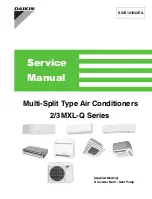
10T8Y1B
VRV-W IV System Air Conditioner
4P399208-1 – 2015.01
Installation and operation manual
19
10.4.5 Leak test
The leak test must satisfy the specifications of EN 378-2:
1
Vacuum leak test:
1.1 Evacuate the system from the liquid and gas piping to
–100.7 kPa (5 Torr) for more than 2 hours.
1.2 Once reached, turn off the vacuum pump and check that the
pressure does not rise for at least 1 minute.
1.3 Should the pressure rise, the system may either contain
moisture (see vacuum drying below) or have leaks.
2
Pressure leak test:
2.1 Break the vacuum by pressurizing with nitrogen gas to a
minimum gauge pressure of 0.2 MPa (2 bar). Never set the
gauge pressure higher than the maximum operation pressure of
the unit, i.e. 4.0 MPa (40 bar).
2.2 Test for leaks by applying a bubble test solution to all piping
connections.
2.3 Discharge all nitrogen gas.
10.4.6 Vacuum drying
To remove all moisture from the system, proceed as follows:
1
Evacuate the system for at least 2 hours to a target vacuum of
–100.7 kPa.
2
Check that, with the vacuum pump turned off, the target vacuum
is maintained for at least 1 hour.
3
Should you fail to reach the target vacuum within 2 hours or
maintain the vacuum for 1 hour, the system may contain too
much moisture.
4
In that case, break the vacuum by pressurizing with nitrogen gas
to a gauge pressure of 0.05 MPa (0.5 bar) and repeat steps 1 to
3 until all moisture has been removed.
5
The outdoor unit stop valves can now be opened, and/or
additional refrigerant can be charged. Refer to
.
11. Pipe insulation
After finishing the leak test and vacuum drying, the piping must be
insulated. Take into account the following points:
Make sure to insulate the connection piping and refrigerant
branch kits entirely.
Be sure to insulate the liquid and gas piping (for all units).
Use heat resistant polyethylene foam which can withstand a
temperature of 70°C for liquid piping and polyethylene foam
which can withstand a temperature of 120°C for gas piping.
Reinforce the insulation on the refrigerant piping according to
the installation environment.
Condensation might form on the surface of the insulation.
If there is a possibility that condensation on the stop valve might
drip down into the indoor unit through gaps in the insulation and
piping because the outdoor unit is located higher than the indoor
unit, this must be prevented by sealing up the connections. See
below figure.
12. Water piping work
The water pressure resistance of water piping of this outdoor
unit is 1.96 MPa.
The pipe connection on the unit is made of stainless steel.
Connecting a water pipe made of a material other than stainless
steel may result in corrosion of the pipe.
Take preventive measures as necessary, for example by
insulating the connection on the water pipe.
The connection port for water piping is located in the front. The
connection ports for drain piping are located in the front and
back. When using the back port, change the plug from the back
to the front and securely close it.
Because the outdoor unit is to be installed indoors, carry out the
piping work in such a way that no water may drip on the unit.
The lateral length of the drain piping should be short (within
400 mm) and installed in a downward direction.
The diameter of the drain pipe should be the same as the
diameter of the drain connection on the unit (1/2B) or larger.
The diameter of the water pipe should be the same as the
diameter of the water connection on the unit (1-1/4) or larger.
Install an air purge valve halfway along the water piping to
prevent cavitation.
After completing the drain piping work, make sure that the water
runs smoothly without any clogging by dirt.
Which valves?
State of valves
State of valves A, B, C and D and
stop valves
Performing the airtightness test and
vacuum drying (Valve A must always
be closed. Otherwise the refrigerant
in the unit will pour out.)
Valve A
Closed
Valve B
Open
Valve C
Open
Valve D
Open
Liquid stop valve
Closed
Suction gas stop valve
Closed
HP/LP stop valve
Closed
NOTICE
The connections to the indoor units and all indoor units
should also be leak and vacuum tested. Keep any possible
(field supplied) field piping valves open as well.
Refer to the indoor unit installation manual for more details.
Leak test and vacuum drying should be done before the
power supply is set to the unit. If not, see also the flow
chart earlier described in this chapter (see
NOTICE
Make sure to use a recommended bubble test solution
from your wholesaler. Do not use soap water, which may
cause cracking of flare nuts (soap water may contain salt,
which absorbs moisture that will freeze when the piping
gets cold), and/or lead to corrosion of flared joints (soap
water may contain ammonia, which causes a corrosive
effect between the brass flare nut and the copper flare).
INFORMATION
After opening the stop valve, it is possible that the pressure
in the refrigerant piping does not rise. This might be
caused by e.g., the closed state of the expansion valve in
the outdoor unit circuit, but does not present any problem
for correct operation of the unit.
NOTICE
The connections to the indoor units and all indoor units
should also be leak and vacuum tested. Keep, if existing,
all (field supplied) field valves to the indoor units open as
well.
Leak test and vacuum drying should be done before the
power supply is set to the unit. If not, see
for more information.
Ambient temperature
Humidity
Minimum thickness
≤
30°C
75% to 80% RH
15 mm
>30°C
≥
80% RH
20 mm
















































